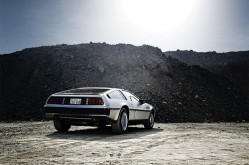Intelligent design
The intention of design should include purpose and course. Intelligent design dictates the intellectual property of design that I have referred, design that extends beyond aesthetics and leads to an absolute solution. The solution should be direct and intuitive; users guided through productivity and function by an innate conscience of efficiency and sustainability. If the purpose of locks and handles were to ensure privacy or commend access, this example by designer Arnaud Lapierre supposedly represented such philosophy by an intelligent solution. If the room is accessible then it is visually and intuitively represented by an extruding handle. If not then the handle is retracted, hence no handle, no access. It needs not delicate locks and colored indicators that represent the condition of the room, the solution is efficient and straightforward, addressing the situation by a direct interpretation that it satisfies.
Products are solutions to problems, yet they often promote further problems than it regards. The problem with the contemporary society, beyond the billions of “problems” our society is plagued by, is a false apprehension and gratification of course and order. The effort to increase global awareness of the environmental crisis is a respectable beginning, but is immensely insufficient. For one the campaigns leave little to know for how the individual should comprehend, and second what little can be done by the collective population. The problem actually, is dictated by the multinationals corporations that exploit our world for their profits. Consider the automotive industry, one of the leading sources of environmental impact. The consumer environment is command and controlled by de facto multinationals. How are no emission electric automobiles rejected in environmental agendas? Are we to believe that hybrids are the absolute solution to environmental impacts? The government tends to think so, only because both the automobile and energy sectors exert prominent forces on economical and political influence. This leaves burden on aspiring directors and designers, to dictate a healthy consumer environment that respects our environmental obligations by means of intelligent design.

In a way intelligent design is going back to design fundamentals; to reconsider our problems and regenerate solutions that comprehend fundamental principles. Though this time around the consequences and negative costs, environmental effects and exploits, are known and thus rejected in the process. To design a chair is to compose a piece that yields perfect comfort, the intended function, by our experience of ergonomics and technology, and achieve an aesthetically pleasurable form remember, by sustainable resource consumption and minimal end of life waste. If we return to the automobile sector, actually come to think of it, what need is there if we need not travel? Is there an opportunity to yield a self sustaining neighborhood by efficient and intuitive urban and structural planning? Intelligent design appreciates the balance of function, form, fundamentals, the original intention, and future, being our environmental obligations.
There is no chance the automobile industry would consider that as an option one may say. Definitely not, it is an ideal solution. The effect on society and culture would be immense, let alone the changes in lifestyle. Reject the capitalistic economy, the monetary, fiscal driven lifestyle, and actualize the true welfare of living; welcome change. The introduction of hybrid vehicles is a gradual change, but beyond hybrids there will be another shift to fuel cells and other formulated propaganda. To take on long term gradual changes, the intellectual solution is to approach an immense change and readjust. Certainly the emerged labor surplus can be more beneficial to shift and adapt to other valued sectors. The government needs to take on an administrative role in multinational command and control, and not the contrary. Hybrids are not the absolute solution; fund the research that is, and not promote that which isn’t. The government and industries very well know that if change is economically or politically beneficial, a decade is not an unrealistic time frame. The woes of contemporary living.

So what can be done by the individual? The consumer environment is dictated by directors and designers, it would be their leading role to inflict intellectual change on the individual and to the collective population. Design by delivering cause, being the statement brought forth in intelligent design by identifiable high design. Individuals are intellectually selective in consumption, intuitively realizing and recognizing moral choices and what should be absolutely necessary. To increase dispersion and global adaptation, be economical in pricing, because of course, it is for the welfare of the environment rather than corporate interest. It should be economical anyways by reduced resource consumption. The mass effect is an exponential global adaptation of high design products that respect environmental obligations. Design and lead by example.
Corporate directors can be intelligent designers. They should mutually dictate the course in which this philosophy can strive by. Function, form, fundamentals and future; principles in which our society should be driven as a process to enhance our public welfare, meanwhile, return the environment to nature. Respect and appreciate nature; humans are merely a component.
1. La condition, Arnaud Lapierre.
2. A Wide Open Future, Al Gore’s American Life, TIME.
3. Ginza Apple Store, Kusou Gallery, Flickr.









